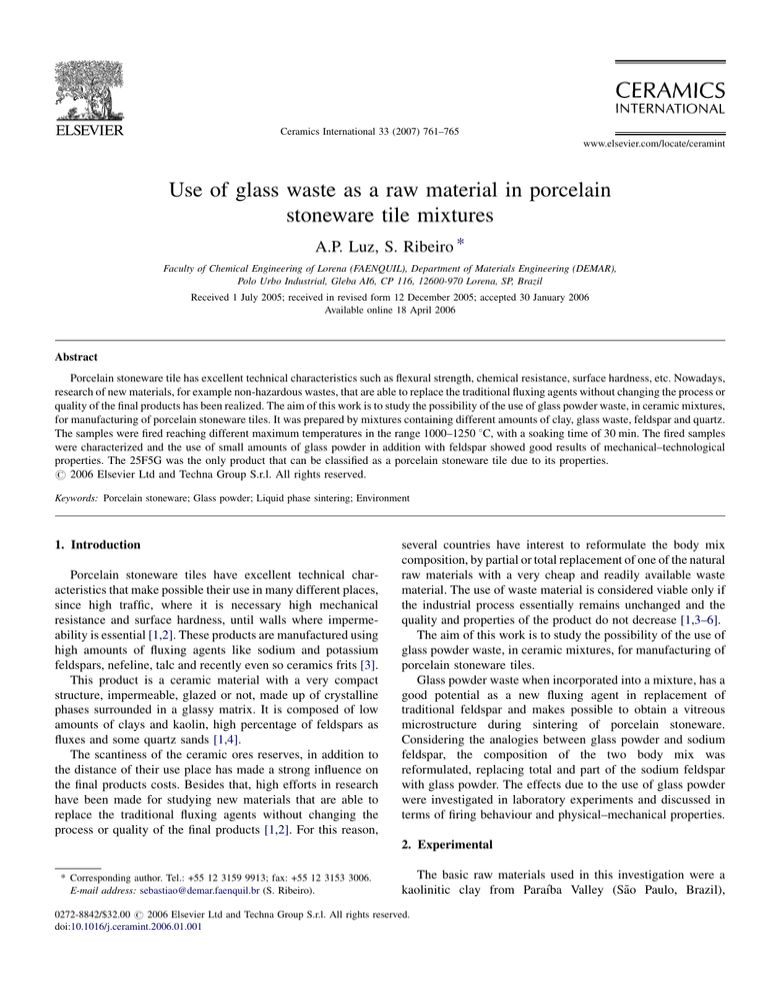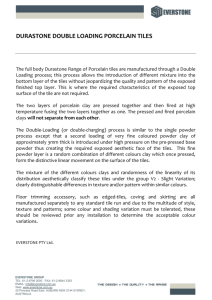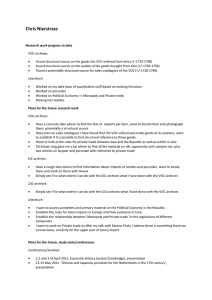
Ceramics International 33 (2007) 761–765
www.elsevier.com/locate/ceramint
Use of glass waste as a raw material in porcelain
stoneware tile mixtures
A.P. Luz, S. Ribeiro *
Faculty of Chemical Engineering of Lorena (FAENQUIL), Department of Materials Engineering (DEMAR),
Polo Urbo Industrial, Gleba AI6, CP 116, 12600-970 Lorena, SP, Brazil
Received 1 July 2005; received in revised form 12 December 2005; accepted 30 January 2006
Available online 18 April 2006
Abstract
Porcelain stoneware tile has excellent technical characteristics such as flexural strength, chemical resistance, surface hardness, etc. Nowadays,
research of new materials, for example non-hazardous wastes, that are able to replace the traditional fluxing agents without changing the process or
quality of the final products has been realized. The aim of this work is to study the possibility of the use of glass powder waste, in ceramic mixtures,
for manufacturing of porcelain stoneware tiles. It was prepared by mixtures containing different amounts of clay, glass waste, feldspar and quartz.
The samples were fired reaching different maximum temperatures in the range 1000–1250 8C, with a soaking time of 30 min. The fired samples
were characterized and the use of small amounts of glass powder in addition with feldspar showed good results of mechanical–technological
properties. The 25F5G was the only product that can be classified as a porcelain stoneware tile due to its properties.
# 2006 Elsevier Ltd and Techna Group S.r.l. All rights reserved.
Keywords: Porcelain stoneware; Glass powder; Liquid phase sintering; Environment
1. Introduction
Porcelain stoneware tiles have excellent technical characteristics that make possible their use in many different places,
since high traffic, where it is necessary high mechanical
resistance and surface hardness, until walls where impermeability is essential [1,2]. These products are manufactured using
high amounts of fluxing agents like sodium and potassium
feldspars, nefeline, talc and recently even so ceramics frits [3].
This product is a ceramic material with a very compact
structure, impermeable, glazed or not, made up of crystalline
phases surrounded in a glassy matrix. It is composed of low
amounts of clays and kaolin, high percentage of feldspars as
fluxes and some quartz sands [1,4].
The scantiness of the ceramic ores reserves, in addition to
the distance of their use place has made a strong influence on
the final products costs. Besides that, high efforts in research
have been made for studying new materials that are able to
replace the traditional fluxing agents without changing the
process or quality of the final products [1,2]. For this reason,
several countries have interest to reformulate the body mix
composition, by partial or total replacement of one of the natural
raw materials with a very cheap and readily available waste
material. The use of waste material is considered viable only if
the industrial process essentially remains unchanged and the
quality and properties of the product do not decrease [1,3–6].
The aim of this work is to study the possibility of the use of
glass powder waste, in ceramic mixtures, for manufacturing of
porcelain stoneware tiles.
Glass powder waste when incorporated into a mixture, has a
good potential as a new fluxing agent in replacement of
traditional feldspar and makes possible to obtain a vitreous
microstructure during sintering of porcelain stoneware.
Considering the analogies between glass powder and sodium
feldspar, the composition of the two body mix was
reformulated, replacing total and part of the sodium feldspar
with glass powder. The effects due to the use of glass powder
were investigated in laboratory experiments and discussed in
terms of firing behaviour and physical–mechanical properties.
2. Experimental
* Corresponding author. Tel.: +55 12 3159 9913; fax: +55 12 3153 3006.
E-mail address: sebastiao@demar.faenquil.br (S. Ribeiro).
The basic raw materials used in this investigation were a
kaolinitic clay from Paraı́ba Valley (São Paulo, Brazil),
0272-8842/$32.00 # 2006 Elsevier Ltd and Techna Group S.r.l. All rights reserved.
doi:10.1016/j.ceramint.2006.01.001
762
A.P. Luz, S. Ribeiro / Ceramics International 33 (2007) 761–765
supplied by Nova Canas Sociedade Agro-Industrial Ltda;
sodium feldspar, supplied by Prominex Mineração Ltda, which
presents melting point of 1120 8C; glass powder waste, which is
a waste material generated due to glass pieces stonecutting and
washing, supplied by Pilkington Brazil Ltda; and quartz powder
with 99.9% purity. The grain size distribution of the raw
materials presents cumulative curves that indicate 50% of the
particles are below 10 mm and that all the particles have
diameters below 40 mm. The chemical analysis of the raw
materials, determined by inductively coupled plasma optical
emission spectroscopy is reported in Table 1.
It was prepared by different mixtures whose compositions
are reported in Table 2. The amount of glass powder waste
added to mixtures was based on the amounts of Na2O and K2O
of this waste and correlated with was used in works presents in
literature [1,2].
The raw materials were mixed in an alumina ball mill using
alumina milling media and water for 1 h. The slurry was dried
at 100 8C in a rotating drier until 8–10% of humidity.
The dried material was then crushed and sieved to pass
through a 425-mm screen to obtain suitable powders for
pressing. The mixtures were compacted into bar shape
(114 mm 25 mm 7 mm) by uniaxial pressing at 50 MPa.
Firing was carried out in a laboratory electric furnace reaching
different maximum temperatures in the range 1000–1250 8C, at
regular temperature intervals of 50 8C, with a soaking time of
30 min and heating rate of 10 8C min 1. After preliminary
studies, the 20G specimens were fired from 1150 to 1200 8C
and the others from 1200 to 1250 8C, at temperature intervals
of 10 8C.
The firing behaviour was described in terms of linear
shrinkage (ASTM C 326), water absorption (ASTM C 373) and
the total porosity (ASTM C329-88).
The crystalline phases of the fired samples, which present
the best results of linear shrinkage and water absorption, were
identified by X-ray diffraction analysis (XRD, Rich Seiferst &
Co. Isso-Debeyeflex 1001) with Cu ka radiation.
The flexural strength was determined using a universal
testing machine (MTS 810.23M), in three-point bending
fixture, 70 mm support span and with a crosshead speed of
0.5 mm min 1. Abrasion resistance was performed as
described in the standard ISO 10545-6. Weibull’s statistical
analysis was carried out on each set of data with 30 specimens.
Table 1
Chemical composition of the raw materials (wt.%)
Composition
Clay
Feldspar
Glass waste
SiO2
Al2O3
Fe2O3
CaO
MgO
Na2O
K2 O
TiO2
L.O.I.
SO2
50.94
28.20
3.41
0.17
0.84
0.19
2.02
0.93
12.80
–
69.00–72.00
16.50–19.50
0.05–0.25
<0.42
<0.01
7.60–8.50
1.00–2.00
–
0.40–0.55
–
72.40
0.70
0.11
8.60
4.00
13.60
0.30
0.02
–
0.20
Table 2
Mixtures compositions (wt.%)
Mixtures
20G
15G
20F10G
25F5G
Raw materials
Clay
Quartz
Feldspar
Glass waste
80.0
73.0
60.0
60.0
–
12.0
10.0
10.0
–
–
20.0
25.0
20.0
15.0
10.0
5.0
Weibull’s modulus, m, was determined by squares method,
adopting as probability estimator of failure Pn = (I 0.5)/N,
where N is the number of strength measurements and I the
ranking number, with I = 1 for the weakest specimen and I = N
for the strongest [7,8].
3. Results and discussion
Densification was monitored by measuring linear shrinkage
and water absorption. The 20G specimens which present the
highest clay content with respect to other bodies, showed the
highest shrinkage values. And the compositions, with quartz
added, as expected, showed small shrinkage (Fig. 1a and b).
The firing behaviour shown by the compositions 20G, 15G and
20F10G present an increase of shrinkage from 1200 to 1250 8C
(Fig. 1a), that indicate an overfiring; this phenomenon only
occurs from 1240 to 1250 8C in 25F5G (Fig. 1b), it means that
highest amount of feldspar extend the firing range.
Water absorption is an important parameter in ceramic tiles,
that defines the class to which the product belong and according
to ISO 13006 standard porcelain stoneware presents values
below 0.5%. Fig. 2a and b show that all the specimens present
values below 0.5% and the replacement of sodium feldspar with
glass powder resulted in a lower firing temperature only for the
composition 20G that reach values of approximately 0.0% at
1150 8C. So all the composition can be classified in the range
used for porcelain stoneware as far as water absorption is
concerned.
Replacing different amounts of feldspar with glass in a
porcelain stoneware mix changes the amounts of the different
alkalis in the mixture [1,2]. Increasing the amount of glass
powder in the mixture, the amount of calcium and magnesium
increases, but the amount of alumina decreases. The firing
behaviours shown by the mixtures can be attributed to the
changes in composition resulting from the replacement total
and partial of the feldspar with the glass, which led to
differences in the viscosity of the liquid formed at the firing
temperatures used to produce the porcelain stoneware tile [2,7–
9]. The fired specimens of 20G mixture present insignificant
variation of linear shrinkage and water absorption values in the
interval of 1150–1200 8C, so it was chosen 1150 (20G), 1200
(15G and 20F10G) and 1220 8C (25F5G) as the temperatures
which was reached the better values of linear shrinkage and
water absorption for the mixtures.
Flexural strength depends on the material composition and
dimension and morphology of the flaws. The mechanical
behaviour of the specimens can be explained taking into
A.P. Luz, S. Ribeiro / Ceramics International 33 (2007) 761–765
763
Fig. 1. Linear shrinkage of the fired samples from 1200 to 1250 8C with
intervals of (a) 50 8C and (b) 10 8C.
Fig. 2. Water absorption of the fired samples from 1200 to 1250 8C with
intervals of (a) 50 8C and (b) 10 8C.
account the different microstructures developed during firing
[10–12]. At the maximum firing temperature the average
modulus of rupture values are between 39 and 46 MPa
(Table 3), these values are in accordance with standard ISO
10545-4 that requires values higher than 27 MPa. The presence
of feldspar and glass, favouring the developing of a more
compact microstructure, with lower porosity than 20G and
15G, causes the observed increase of modulus of rupture, for
20F10G and 25F5G. The flexural strength reaches the
maximum value for 20F10G, characterized by the presence
of pores with narrowed sizes (Fig. 3c). The increase in
Weibull’s modulus is further evidence of improved microstructural homogeneity and high performance is required of
porcelain stoneware tiles, so the reliability of the product
represents a very important parameter.
The use of glass causes a formation of a lower viscosity of
the liquid phase, that decreases with the increase of glass
powder, favors the shrinkage, but also the growing of rather
large closed pores (Fig. 3), that trapped in the glassy matrix
during cooling [1,2,10], cause the observed expansion of 20G
Table 3
Physical mechanical properties of the fired samples
Sample
Total porosity (%)
Modulus of
rupture (MPa)
Weibull’s
modulus (m)
Abrasion resistance
(volume removed, mm3)
20G (1150 8C)
15G (1200 8C)
20F10G (1200 8C)
25F5G (1220 8C)
14.0
13.1
12.0
12.7
39.0
40.0
46.0
44.1
3.4
7.6
10.6
7.8
195.3
191.5
188.8
164.2
764
A.P. Luz, S. Ribeiro / Ceramics International 33 (2007) 761–765
Fig. 3. Fracture surface micrographs: (a) 20G, 1150 8C 1000; (b) 15G, 1200 8C 2000; (c) 20F10G, 1200 8C 2000; and (d) 25F5G, 1220 8C 2000.
specimens at 1200–1250 8C. This is in agreement with the
results of porosity. According to literature [1,2], the use of
scrap-glass cause a general increase in porosity, but besides
the high values of porosity (12.0–14.0%) the mechanical
characteristics, as modulus of rupture, of the tested materials
are still in accordance with the standard for porcelain
stoneware.
The crystalline phases identified in all the samples fired
are quartz and mullite (Fig. 4). Quartz is a residual mineral
from the original raw materials, and mullite, formed during
firing. Porcelain stoneware bodies generally contain a single
mullite phase, 3Al2O32SiO2, evolution pathway: the dehydroxylated kaolin, metakaolin, transforms into a nonequilibrium unstable spinel type structure, which converts to mullite
above 1075 8C [10,13]. For the compositions containing glass
powder some modifications in intensity and position of the
peaks in the X-ray diffraction patterns indicate the presence of
anorthite, and the amount of which increases with increasing
percentage of glass.
The abrasion resistance of the fired specimens was checked
according to ISO 10545-6 and measured in terms of removed
sample volume (Table 3). The values are all located in the range
164.2–195.3 mm3 for the specimens fired at high temperature,
according to the maximum densification reached. According to
literature [10,13], porcelain stoneware must present abraded
volume values lower than 175 mm3. 20G, 15G and 20F10G
present high values of abraded volume due to the high amount
of total porosity in the samples, so they cannot be classified as
porcelain stoneware. In spite of the high values of porosity
found in all specimens tested, the 25F5G samples present
modulus of rupture, water absorption and abrasion resistance
values in accordance with the standards for porcelain stoneware. So, 25F5G is the only product that can be classified as a
porcelain stoneware and the others ones did not achieve all the
requirements necessary, but they can be classified in other
category of ceramic tile.
4. Conclusions
Fig. 4. X-ray diffraction patterns: (a) 20G, 1150 8C; (b) 15G, 1200 8C; (c)
20F10G, 1200 8C; and (d) 25F5G, 1220 8C.
The glass powder waste shows to be an efficient fluxing agent
when it is used as an additive in ceramic mixture. During firing
glass powder waste accelerates the densification process, with
some positive effects (lower open porosity, water absorption)
combined with negative ones (higher values of shrinkage and
high closed porosity). The use of small amounts of glass powder
in addition with feldspar showed good results of mechanical and
technological properties and Weibull’s modulus, which is an
important parameter that represents the reliability of the product.
The 25F5G is the only product that can be classified as a
porcelain stoneware tile due to its properties.
A.P. Luz, S. Ribeiro / Ceramics International 33 (2007) 761–765
Acknowledgements
The authors would like to acknowledge the financial support
of the Brazilian research funding institution FAPESP (Process
no. 02/13491-8) and Pilkington Brazil Ltda, which support the
development of this work.
References
[1] A. Tucci, L. Esposito, E. Rastelli, C. Palmonari, E. Rambaldi, Use of sodalime scrap-glass as a fluxing agent in a porcelain stoneware tile mix, J. Eur.
Ceram. Soc. 24 (1) (2004) 83–92.
[2] F. Matteucci, M. Dondi, G. Guarini, Effect of soda-lime glass on sintering
and technological properties of porcelain stoneware tiles, Ceram. Int. 28
(8) (2002) 873–880.
[3] R. Gennaro, P. Cappelletti, G. Cerri, M. Gennaro, M. Dondi, G. Guarini,
A. Langella, D. Naimo, Influence of zeolites on sintering and technological properties of porcelain stoneware tiles, J. Eur. Ceram. Soc. 23 (13)
(2003) 2237–2245.
[4] M.F. Abadir, E.H. Sallam, I.M. Bakr, Preparation of porcelain tiles from
Egyptian raw materials, Ceram. Int. 28 (3) (2002) 303–310.
[5] P. Appendino, M. Ferraris, I. Matekovits, M. Salvo, Production of glassceramic bodies from the bottom ashes of municipal solid waste incinerators, J. Eur. Ceram. Soc. 24 (2004) 803–810.
765
[6] M. Campos, F. Velasco, M.A. Martinez, J.M. Torralba, Recovered slate
waste as raw material for manufacturing sintered structural tiles, J. Eur.
Ceram. Soc. 24 (2004) 811–819.
[7] V.K. Marghussian, A. Maghsoodipoor, Fabrication of unglazed floor tiles
containing Iranian copper slags, Ceram. Int. 25 (1999) 617–622.
[8] C.R. Cheeseman, C.J. Sollars, S. Mcentee, Properties, microstructure and
leaching of sintered sewage sludge ash, Res. Conserv. Recycl. 40 (2003)
13–25.
[9] P. Duran, J. Tarjat, C. Moure, Sintering behavior and microstructural
evolution of agglomerated spherical particles of high-purity barium
titanate, Ceram. Int. 29 (2003) 419–425.
[10] C. Leonelli, F. Bondioli, P. Veronesi, M. Romagnoli, T. Manfredini, G.C.
Pellacani, V. Cannillo, Enhancing the mechanical properties of porcelain
stoneware tiles: a microstructural approach, J. Eur. Ceram. Soc. 21 (6)
(2001) 785–793.
[11] L. Esposito, A. Salem, A. Tucci, A. Gualtieri, S.H. Jazayeri, The use of
nepheline-syenite in a body mix for porcelain stoneware tiles, Ceram. Int.
31 (2) (2005) 233–240.
[12] M.S. Hernández-Creso, J.Ma. Rincón, New porcelainized stoneware
materials obtained by recycling of MSW incinerator fly ashes and granite
sawing residues, Ceram. Int. 27 (2001) 713–720.
[13] M. Dondi, G. Ercolani, C. Melandri, C. Mingazzini, M. Marsigli, The
chemical composition of porcelain stoneware tiles and its influence
on microstructural and mechanical properties, Interceram 28 (2) (1999)
75–82.




